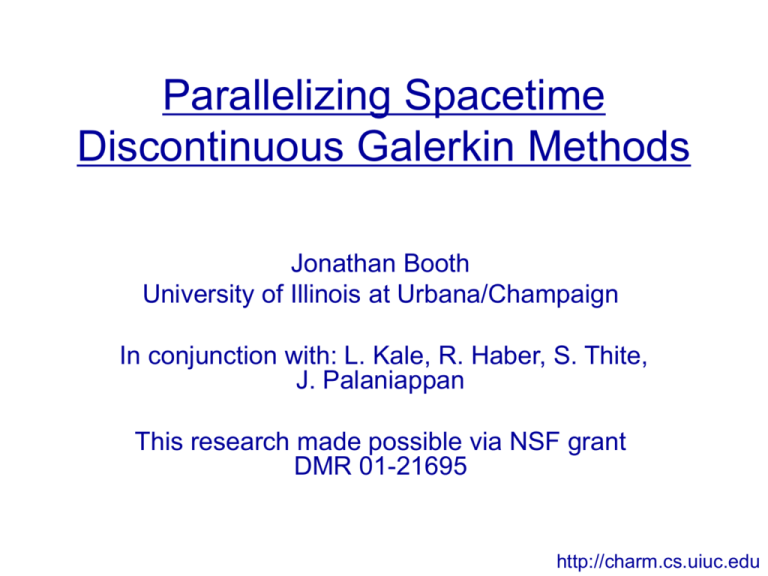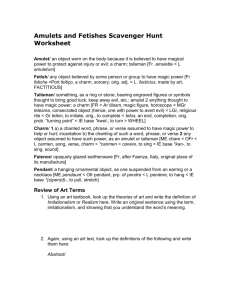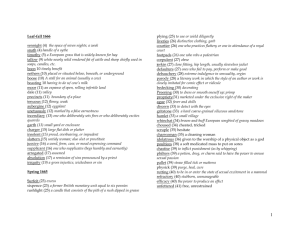talk - Parallel Programming Laboratory
advertisement

Parallelizing Spacetime Discontinuous Galerkin Methods Jonathan Booth University of Illinois at Urbana/Champaign In conjunction with: L. Kale, R. Haber, S. Thite, J. Palaniappan This research made possible via NSF grant DMR 01-21695 http://charm.cs.uiuc.edu Parallel Programming Lab • Led by Professor Laxmikant Kale • Application-oriented – Research is driven by real applications and the needs of real applications • • • • NAMD CSAR Rocket Simulation (Roc*) Spacetime Discontinuous Galerkin Petaflops Performance Prediction (Blue Gene) – Focus on scaleable performance for real applications http://charm.cs.uiuc.edu Charm++ Overview • In development for roughly ten years • Based on C++ • Runs on many platforms – Desktops – Clusters – Supercomputers • Overlays a C layer called Converse – Allows multiple languages to work together http://charm.cs.uiuc.edu Charm++: Programmer View Processor Object/Task • System of objects • Asynchronous communication via method invocation • Use an object identifier to refer to an object. • User sees each object execute its methods atomically – As if on its own processor http://charm.cs.uiuc.edu Charm++: System View • Set of objects invoked by messages • Set of processors of the physical machine • Keeps track of object to processor mapping • Routes messages between objects Processor Object/Task http://charm.cs.uiuc.edu Charm++ Benefits • Program is not tied to a fixed number of processors – No problem if program needs 128 processors and only 45 available – Called processor virtualization • Load balancing accomplished automatically – User writes a short routine to transfer object between processors http://charm.cs.uiuc.edu Load Balancing - Green Process Starts Heavy Computation A B C http://charm.cs.uiuc.edu Yellow Processes Migrate Away – System Handles Message Routing A A B B C C http://charm.cs.uiuc.edu Load Balancing • Load balancing isn’t solely dependant on CPU usage • Balancers consider network usage as well – Can move objects to lessen network bandwidth usage • Migrating an object to disk instead of another processor gives checkpoint/restart, out-of-core execution http://charm.cs.uiuc.edu Parallel Spacetime Discontinuous Galerkin • Mesh generation is an advancing front algorithm – Adds an independent set of elements called patches to the mesh • Spacetime methods are setup in such a way they are easy to parallelize – Each patch depends only on inflow elements • Cone constraint insures no other dependencies – Amount of data per patch is small • Inexpensive to send a patch and its inflow elements to another processor http://charm.cs.uiuc.edu Mesh Generation Unsolved Patches Mesh Generation Unsolved Patches Solved Patches Mesh Generation Refinement Unsolved Patches Solved Patches Parallelization Method (1D) • Master-Slave method – Centralized mesh generation – Distributed physics solver code – Simplistic implementation • But fast to get running • Provides object migration sanity check • No “time-step” – as soon as a patch returns the master generates any new patches it can and sends them off to be solved http://charm.cs.uiuc.edu Results - Patches / Second Patches/Second 250 200 150 100 50 0 0 10 20 Processors 30 40 http://charm.cs.uiuc.edu Scaling Problems • Speedup is ideal at 4 slave processors • After 4 slaves, diminishing speedup occurs • Possible sources: – Network bandwidth overload – Charm++ system overhead (grainsize control) – Mesh generator overload • Problem doesn’t scale-down – More processors don’t slow the computation down http://charm.cs.uiuc.edu Network Bandwidth • Size of a patch to send both ways is 2048 bytes (very conservative estimate) • Can compute 36 patches/(second*CPU) • Each CPU needs 72kbytes/second • 100Mbit Ethernet provides 10Mbyte/sec • Network can support ~130 CPUs – Must not be a lack of network bandwidth http://charm.cs.uiuc.edu Charm++ System Overhead (Grainsize Control) • Grainsize is a measure of the smallest unit of work • Too small and overhead dominates – Network latency overhead – Object creation overhead • Each patch takes 1.7ms to setup the connection to send (both ways) • Can send ~550 patches/sec to remote processors – Again, higher than observed patch/second rate • Grainsize can be reduced by sending multiple patches at once – Speeds up the computation but speedup still flattens out after 8 processors http://charm.cs.uiuc.edu Mesh Generation • With 0 slave processors, 31ms/patch • With 1 slave processor, 27ms/patch • Geometry code takes 4ms to generate a patch – Mesh generator needs a bit more time due to Charm++ message sending overhead • Leads to less than 250 patches/second • Can’t trivially speed this up – Would have to parallelize mesh generation – Parallel mesh generation also would lighten network load if the mesh were fully distributed to slave nodes http://charm.cs.uiuc.edu Testing the Mesh Generator Bottleneck • Does speeding up the mesh generator give better results? • Leaves the question how to speed up the mesh generator – The cluster used is a P3 Xeon 500Mhz – So run the mesh generator on something faster (a P4 2.8Ghz) – Everything still on 100Mbit network Patches/Sec Fast Mesh Generator Results 900 800 700 600 500 400 300 200 100 0 0 5 10 15 20 Processors 25 30 35 Future Directions • Parallelize geometry/mesh generation – Easy to do in theory – More complex in practice with refinement, coarsening – Lessens network bandwidth consumption • Only have to send border elements of all meshes • Compared to all elements sent right now – Better cache performance http://charm.cs.uiuc.edu More Future Directions • Send only necessary data – Currently send everything, needed or not • Use migration to balance load rather than slaves – Means we’ll also get checkpoint/restart and out-ofcore execution for free – Also means we can load balance away some of the network communication • Integrate 2D mesh generation/physics code – Nothing in the parallel code knows the dimensionality http://charm.cs.uiuc.edu






